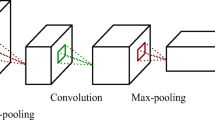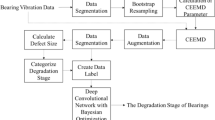Abstract
Introduction
An effective data-driven bearing fault diagnosis has been moving away from traditional reliance on statistical features toward a focus on raw time-domain analysis. This transition is driven by the need to preserve the critical information contained within the signals.
Purpose
In machinery maintenance, a challenge arises when attempting to detect bearing faults under extremely low operating conditions. This is due to the minimal interaction between the rolling element and the fault at such speeds. In response to this, the research aims to tackle the issue of bearing fault detection under these low-speed operating conditions by introducing an advanced fault diagnosis approach.
Method
The proposed method involves the utilization of acoustic emission and vibration sensors to capture the vibration behavior of the bearing component at low operating conditions. Importantly, a data fusion strategy is adopted to fuse the raw signals obtained from both sensor types. These fused signals are then directly input into the novel one-dimensional optimized convolutional neural network (1D-CNN). To further enhance the model’s performance, a differential evolution algorithm is leveraged for the optimization of its hyperparameters. To validate the effectiveness of the approach, a preliminary analysis is initially conducted using the CWRU dataset, comparing the diagnosis accuracy of the proposed model to existing literature results. Subsequently, the model’s performance is evaluated using experimental data collected under low operating speed conditions, spanning a range from 48 rpm (extremely low speed) to 300 rpm (low speed).
Result
The results showcase the remarkable capability of the DE-1D-CNN model to diagnose the presence of bearing faults under low-speed conditions, with the highest achieved accuracy standing at an impressive 100%. Through the judicious optimization of hyperparameters, the proposed 1D-CNN model proves its competence in bearing fault diagnosis even when the signal was collected under challenging low-speed operating conditions.













Similar content being viewed by others
Data availability
The data used to support the findings of this study are available from the corresponding author upon reasonable request.
Change history
22 December 2023
A Correction to this paper has been published: https://doi.org/10.1007/s42417-023-01264-1
References
Ab Wahab MN, Nefti-Meziani S, Atyabi A (2015) A comprehensive review of swarm optimization algorithms. PLoS One 10:1–36. https://doi.org/10.1371/journal.pone.0122827
Alexakos CT, Karnavas YL, Drakaki M, Tziafettas IA (2021) A combined short time Fourier transform and image classification transformer model for rolling element bearings fault diagnosis in electric motors. Mach Learn Knowl Extr 3:228–242. https://doi.org/10.3390/make3010011
Faysal A, Ngui WK, Lim MH, Lim MS (2022) Ensemble augmentation for deep neural networks using 1-D time series vibration data. J Vib Eng Technol 11:1987–2011. https://doi.org/10.1007/s42417-022-00683-w
Cho H, Kim Y, Lee E et al (2020) Basic enhancement strategies when using Bayesian optimization for hyperparameter tuning of deep neural networks. IEEE Access 8:52588–52608. https://doi.org/10.1109/ACCESS.2020.2981072
Eftekharnejad B, Addali A (2011) Defect source location of a natural defect on a high speed- rolling element bearing with Acoustic Emission. In: Annual conference of the PHM Society, vol 3, no 1. https://doi.org/10.36001/phmconf.2011.v3i1.2033
Ghorvei M, Kavianpour M, Beheshti MTH, Ramezani A (2023) Spatial graph convolutional neural network via structured subdomain adaptation and domain adversarial learning for bearing fault diagnosis. Neurocomputing 517:44–61. https://doi.org/10.1016/j.neucom.2022.10.057
Habbouche H, Amirat Y, Benkedjouh T, Benbouzid M (2021) Bearing fault event-triggered diagnosis using a variational mode decomposition-based machine learning approach. IEEE Trans Energy Convers 8969:1–9. https://doi.org/10.1109/TEC.2021.3085909
He J, Li X, Chen Y et al (2021) Deep transfer learning method based on 1D-CNN for bearing fault diagnosis. Shock Vib. https://doi.org/10.1155/2021/6687331
Jian X, Li W, Guo X, Wang R (2019) Fault diagnosis of motor bearings based on a one-dimensional fusion neural network. Sensors (Switzerland) 19:122. https://doi.org/10.3390/s19010122
Jiang W, Hu W, Xie C (2017) A new engine fault diagnosis method based on multi-sensor data fusion. Appl Sci 7:280. https://doi.org/10.3390/app7030280
Khorram A, Khalooei M, Rezghi M (2021) End-to-end CNN + LSTM deep learning approach for bearing fault diagnosis. Appl Intell 51:736–751. https://doi.org/10.1007/s10489-020-01859-1
Li X, Yang Y, Pan H et al (2019) A novel deep stacking least squares support vector machine for rolling bearing fault diagnosis. Comput Ind 110:36–47. https://doi.org/10.1016/j.compind.2019.05.005
Liu R, Yang B, Zio E, Chen X (2018) Artificial intelligence for fault diagnosis of rotating machinery: a review. Mech Syst Signal Process 108:33–47. https://doi.org/10.1016/j.ymssp.2018.02.016
Mao W, Feng W, Liu Y et al (2021) A new deep auto-encoder method with fusing discriminant information for bearing fault diagnosis. Mech Syst Signal Process 150:107233. https://doi.org/10.1016/j.ymssp.2020.107233
Mirjalili S, Lewis A (2016) The Whale optimization algorithm. Adv Eng Softw 95:51–67. https://doi.org/10.1016/j.advengsoft.2016.01.008
Mo Z, Wang J, Zhang H, et al (2019) Vibration and acoustics emission based methods in low-speed bearing condition monitoring. In: Proc—2018 Progn Syst Heal Manag Conf PHM-Chongqing 2018 871–875. https://doi.org/10.1109/PHM-Chongqing.2018.00156
Motoki T, Masahiro ODA (2020) Damage diagnosis of low speed rotating bearings by AE measurement. JEE Tech Rep 25:52–56
Nikula RP, Karioja K, Pylvänäinen M, Leiviskä K (2020) Automation of low-speed bearing fault diagnosis based on autocorrelation of time domain features. Mech Syst Signal Process 138:106572. https://doi.org/10.1016/j.ymssp.2019.106572
Pascanu R, Mikolov T, Bengio Y (2013) On the difficulty of training recurrent neural networks. 30th Int Conf Mach Learn ICML 2013 2347–2355
Manikandan S, Duraivelu K (2023) Vibration-based fault diagnosis of broken impeller and mechanical seal failure in industrial mono-block centrifugal pumps using deep convolutional neural network. J Vib Eng Technol 11:141–152. https://doi.org/10.1007/s42417-022-00566-0
Sandoval D, Leturiondo U, Vidal Y, Pozo F (2021) Entropy indicators: an approach for low-speed bearing diagnosis. Sensors (Switzerland) 21:1–34. https://doi.org/10.3390/s21030849
Saufi MSRBM, Bin Ahmad ZA, Leong MS, Lim MH (2020) Gearbox fault diagnosis using a deep learning model with limited data sample. IEEE Trans Ind Informatics 3203:1–1. https://doi.org/10.1109/tii.2020.2967822
Saufi SR, Ahmad Bin ZA, Leong S, Lim MH (2019) Low-speed bearing fault diagnosis based on ArSSAE model using acoustic emission and vibration signals. IEEE Access 7:46885–46897. https://doi.org/10.1109/ACCESS.2019.2909756
Saufi SR, Ahmad Bin ZA, Leong MS, Lim MH (2019) Challenges and opportunities of deep learning models for machinery fault detection and diagnosis: a review. IEEE Access 7:122644–122662. https://doi.org/10.1109/ACCESS.2019.2938227
Saufi SR, Ahmad Bin ZA, Leong MS, Lim MH (2018) Differential evolution optimization for resilient stacked sparse autoencoder and its applications on bearing fault diagnosis. Meas Sci Technol 29:125002. https://doi.org/10.1088/1361-6501/aae5b2
Shi Z, Chehade A (2021) A dual-LSTM framework combining change point detection and remaining useful life prediction. Reliab Eng Syst Saf 205:107257. https://doi.org/10.1016/j.ress.2020.107257
Sonkul NA, Dhage GS, Vyas NS (2021) Single and Multi-label Fault Classification in rotors from unprocessed multi-sensor data through deep and parallel CNN architectures. Expert Syst Appl 185:115565. https://doi.org/10.1016/j.eswa.2021.115565
Wang X, Mao D, Li X (2021) Bearing fault diagnosis based on vibro-acoustic data fusion and 1D-CNN network. Meas J Int Meas Confed 173:108518. https://doi.org/10.1016/j.measurement.2020.108518
Wei X, Zhang L, Yang HQ et al (2021) Machine learning for pore-water pressure time-series prediction: application of recurrent neural networks. Geosci Front 12:453–467. https://doi.org/10.1016/j.gsf.2020.04.011
Zhang J, Sun Y, Guo L et al (2020) A new bearing fault diagnosis method based on modified convolutional neural networks. Chin J Aeronaut 33:439–447. https://doi.org/10.1016/j.cja.2019.07.011
Zhang J, Yang J, Litak G, Hu E (2019) Feature extraction under bounded noise background and its application in low speed bearing fault diagnosis. J Mech Sci Technol 33:3193–3204. https://doi.org/10.1007/s12206-019-0614-5
Zou F, Zhang H, Sang S et al (2021) Bearing fault diagnosis based on combined multi-scale weighted entropy morphological filtering and bi-LSTM. Appl Intell 51:6647–6664. https://doi.org/10.1007/s10489-021-02229-1
Acknowledgements
The work was supported by the Fundamental Research Grant Scheme (FRGS) from the Ministry of Higher Education (MOHE) Malaysia, Grant No: FRGS/1/2023/TK02/UTM/02/11 and Universiti Teknologi Malaysia. Additionally, thanks to Universiti Teknologi Malaysia for supported this work under grant UTM Fundamental Research Grant Q.J130000.3851.22H06.
Author information
Authors and Affiliations
Corresponding author
Ethics declarations
Conflict of Interest
On behalf of all authors, the corresponding author states that there is no conflict of interest.
Additional information
Publisher's Note
Springer Nature remains neutral with regard to jurisdictional claims in published maps and institutional affiliations.
The original online version of this article was revised: The acknowledgement was not correct.
Rights and permissions
Springer Nature or its licensor (e.g. a society or other partner) holds exclusive rights to this article under a publishing agreement with the author(s) or other rightsholder(s); author self-archiving of the accepted manuscript version of this article is solely governed by the terms of such publishing agreement and applicable law.
About this article
Cite this article
Saufi, M.S.R.M., Isham, M.F., Talib, M.H.A. et al. Extremely Low-Speed Bearing Fault Diagnosis Based on Raw Signal Fusion and DE-1D-CNN Network. J. Vib. Eng. Technol. 12, 5935–5951 (2024). https://doi.org/10.1007/s42417-023-01228-5
Received:
Revised:
Accepted:
Published:
Issue Date:
DOI: https://doi.org/10.1007/s42417-023-01228-5




